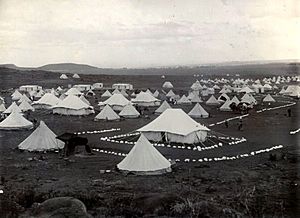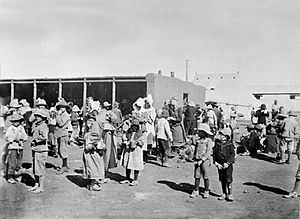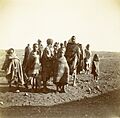Second Boer War concentration camps facts for kids


During the Second Anglo-Boer War, from 1899 to 1902, the British army set up special camps. These camps were in what is now South Africa. They were located in the South African Republic, Orange Free State, Transvaal, and the Cape Colony.
What Were the Camps For?
In 1900, Herbert Kitchener became the leader of the British forces. He started a plan to stop the Boer fighters, known as guerrillas. His plan was to clear the land of anything that could help the guerrillas. This included destroying farms and food supplies.
The British used a plan called "Scorched Earth". This meant they destroyed Boer farms. They burned homes, killed animals, and ruined crops. This was to stop the Boers from getting food or supplies from their homes. Because of this, many thousands of men, women, and children had to leave their homes. They were forced to move into these camps.
These camps were not the first of their kind. Spain had used similar camps in Cuba before. But the Boer War camps were the first time a whole group of people was targeted this way. It was also the first time that entire areas were emptied of people.
Life Inside the Camps
There were 45 camps for Boer people. Also, 64 more camps were built for black Africans. Most of the Boer men captured (about 28,000) were sent overseas. This meant that most people in the local camps were women and children. Sadly, between 18,000 and 26,000 women and children died in these camps. Many died from diseases.
The camps were not managed well from the start. They became very crowded as more people were sent there. Conditions were very bad for the people living in them. There was often not enough food or clean water. Hygiene was poor, and sanitation was bad.
Getting supplies to the camps was difficult. The Boer fighters often attacked the supply lines. Food rations (the amount of food given) were very small. Families of men who were still fighting received even less food.
Poor living conditions led to many illnesses. People suffered from malnutrition (not enough good food). Diseases like measles, typhoid, and dysentery spread easily. Children were especially at risk. There were also not enough modern doctors or hospitals. Because of this, many people in the camps died.
Images for kids
-
Emily Hobhouse worked to improve the terrible conditions in the camps. She helped change public opinion. This made the government improve the camps, leading to the Fawcett Commission.
-
Lord Kitchener was a very important British general in the war. He took charge of British forces. He was responsible for how the British fought against the Boers' guerrilla tactics.




